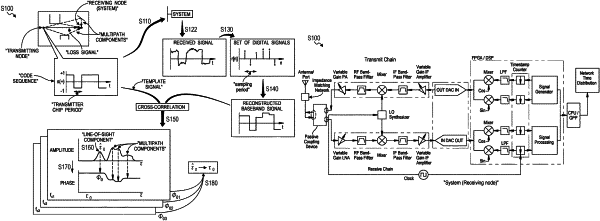| CPC H04W 56/0065 (2013.01) [G01S 5/02 (2013.01); H04L 7/007 (2013.01); H04L 7/06 (2013.01); H04W 56/001 (2013.01); H04W 72/0446 (2013.01)] | 18 Claims |

|
1. A method for detecting times-of-arrival of signals comprising, at a receiving node:
during a first time slot, receiving a first signal comprising a first carrier signal:
characterized by a first carrier frequency; and
modulated by a first template signal defining a first code sequence characterized by a transmitter chip period;
demodulating the first signal according to a first local oscillator frequency to generate a first received baseband signal, the first local oscillator frequency and the first carrier frequency defining a first desynchronization ratio in irreducible form characterized by a first denominator greater than a threshold denominator;
sampling the first received baseband signal at the transmitter chip period to generate a first set of digital samples;
generating, on a fine time grid, a first reconstructed baseband signal based on the first set of digital samples, the fine time grid characterized by a time resolution less than the transmitter chip period;
calculating, on the fine time grid, a first cross-correlation function comprising a cross-correlation of the first reconstructed baseband signal and the first template signal; and
calculating, on the fine time grid, a first time-of-arrival of the first signal based on a first earliest peak time in a first set of peak times, each peak time in the first set of peak times corresponding to a local maximum in a first amplitude response of the first cross-correlation function.
|